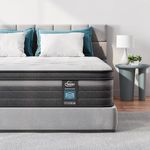Buying Guide for the Best King Size Mattress
Choosing the right king-size mattress is crucial for ensuring a good night's sleep and overall comfort. A king-size mattress offers ample space for couples or individuals who enjoy extra room to stretch out. When selecting a mattress, consider factors such as your sleeping position, any specific health concerns, and personal comfort preferences. It's important to test the mattress if possible, as comfort is subjective and varies from person to person. Additionally, consider the longevity and durability of the mattress to ensure it meets your needs for years to come.Mattress TypeThe type of mattress refers to the materials and construction used, which can significantly affect comfort and support. Common types include innerspring, memory foam, latex, and hybrid. Innerspring mattresses are traditional and offer good support with a bouncy feel. Memory foam mattresses conform to your body, providing pressure relief and motion isolation. Latex mattresses are similar to memory foam but are more responsive and often more durable. Hybrid mattresses combine innerspring coils with foam or latex for a balance of support and comfort. Choose a type based on your comfort preference and any specific needs, such as pressure relief or support.
Firmness LevelFirmness level indicates how soft or hard a mattress feels. It is important because it affects your comfort and spinal alignment during sleep. Firmness is usually rated on a scale from soft to firm. Soft mattresses are plush and allow you to sink in, which is ideal for side sleepers who need pressure relief. Medium-firm mattresses offer a balance of support and comfort, suitable for back sleepers. Firm mattresses provide more support and are often preferred by stomach sleepers or those with back pain. Consider your sleeping position and personal comfort preference when choosing firmness.
Support and Pressure ReliefSupport refers to how well a mattress maintains your body in a comfortable and healthy position, while pressure relief is about reducing stress on specific body parts. A mattress with good support keeps your spine aligned, which is crucial for preventing back pain. Pressure relief is important for reducing discomfort in areas like the shoulders and hips. Memory foam and latex are known for excellent pressure relief, while innerspring and hybrid mattresses often provide better support. Consider your body type and any specific pain points when evaluating these features.
Motion IsolationMotion isolation is the mattress's ability to absorb movement, preventing it from transferring across the bed. This is important for couples, as it minimizes disturbances when one person moves or gets up. Memory foam mattresses typically offer the best motion isolation, while innerspring mattresses may transfer more motion. If you share your bed and are easily disturbed by movement, prioritize a mattress with good motion isolation.
Temperature RegulationTemperature regulation refers to how well a mattress can maintain a comfortable sleeping temperature. This is important for preventing overheating during the night. Some materials, like memory foam, can retain heat, while others, like latex or innerspring, tend to be cooler. Many mattresses now include cooling technologies, such as gel-infused foam or breathable covers, to enhance temperature regulation. If you tend to sleep hot, look for a mattress with good cooling properties.
Edge SupportEdge support is the strength of the mattress's perimeter, which affects how well it holds up when you sit or lie near the edge. Good edge support is important for maximizing usable space and preventing sagging. Innerspring and hybrid mattresses often provide better edge support than all-foam models. If you frequently sit on the edge of the bed or need the full surface for sleeping, consider a mattress with strong edge support.
DurabilityDurability refers to how long a mattress will maintain its comfort and support over time. This is important for ensuring a good return on your investment. Materials like latex and high-density foams are generally more durable than low-density foams. Innerspring mattresses can also be durable if they have high-quality coils. Consider the materials and construction quality when evaluating durability, especially if you plan to use the mattress for many years.














